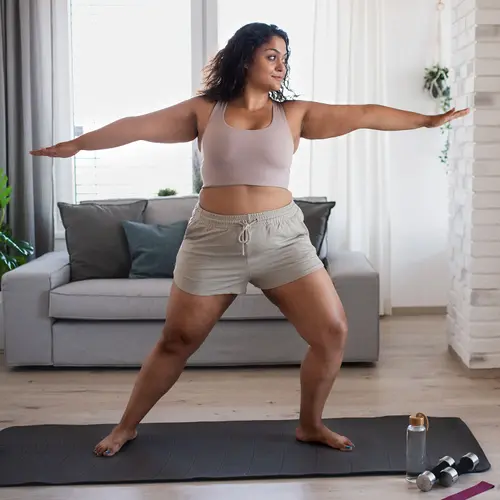How It Works
Step aerobics is a classic cardio workout. It's lasted for decades for a simple reason: It delivers results.
The "step" is a 4-inch to 12-inch raised platform. You step up, around, and down from the platform in different patterns to boost your heart rate and breathing, and strengthen your muscles.
Step aerobics moves range from simple to advanced. The most basic is a step-up, step-down. Once you get more experienced, you do moves that take you over the top and around the step forwards, sideways, and backwards.
Most people take step aerobics classes at a gym, with an instructor showing you each move. The instructor and the upbeat music motivate you to keep going.
Your class will start with a warm-up, followed by choreographed routines on the step, and a cooldown at the end. In some classes, you'll use hand weights for strength-training moves off the step.
Intensity Level: Medium
The intensity level depends on how high you make the step and what kinds of movements you do on it.
For the lowest intensity, put the step flat on the floor. To make it more intense, add risers that raise the step's height. Use your arms, too. The more you raise your arms overhead, the harder you'll work.
Areas It Targets
Core: Yes. Your core muscles stabilize you as you're stepping. You'll also burn fat and get stronger abs.
Arms: Yes. Your lower body is the star of step aerobics, but you may also use your arms and do strength- training exercises with weights specifically for your arms.
Legs: Yes. Stepping up and down works your calves, quadriceps, and hamstrings.
Glutes: Yes. All those step-ups strengthen and tone your buttocks.
Back: Yes. You'll use the muscles in your lower back with each step.
Type
Flexibility: Yes. The fluid motions of stepping will improve your flexibility.
Aerobic: Yes. Your heart will pump harder. You'll sweat as you burn calories.
Strength: Yes. Stepping up and down works the muscles in your calves, legs, and buttocks. Many step aerobics classes add strength-training with weights. Although you can also use light weights while you step, it's best not to, since you could injure your shoulder joint.
Sport: No. If you're an athlete, you might use step aerobics to cross train.
Low-Impact: Yes. You usually keep one foot on the bench or ground, so step aerobics can be a low-impact program.
What Else You Should Know
Cost: If you're planning to do step aerobics at home, you'll need to buy a step and risers, which can run anywhere from $17 to more than $100. You may also want to buy a DVD to walk you through the moves. You can also take a step class at a gym or community center, which will have membership or class fees.
Good for beginners? Yes. Start with basic steps and work your way up to more difficult movements.
Outdoors: No. You could take your step outdoors, but most people do step aerobics in a gym or at home.
At home: Yes. You can set up the step at home and exercise to music or with a workout video.
Equipment required? Yes. You need a step and enough risers to lift it to the height you want.
What Dr. Melinda Ratini Says:
Step aerobics is a great way to get your cardio. To get a complete workout, you should add some strength-building exercises to your routine a couple of times a week, especially for your upper body.
If you like low-tech workouts, or the option of working out on your own in front of a screen, then you will like step aerobics. Because you can easily change the height of the step to fit different fitness levels, step can be a good choice no matter what shape you are in. You also have the choice of enrolling in a class where an instructor can take you through the steps. Think music, dance moves, and stomps.
Step aerobics is not for you if you’d rather be outside. If you want to take a more meditative approach to fitness, walking and yoga are better picks.
Is It Good for Me If I Have a Health Condition?
If you have high blood pressure, high cholesterol, or diabetes, your doctor has likely told you to get up and get moving. Step aerobics is a great way to do this.
If you get into a routine of doing it on most days of the week for at least a half hour at a time, it can help you drop weight and lower your bad (LDL) cholesterol as well as your blood pressure. Lowering these helps prevent heart disease. It can raise your good cholesterol (HDL), too.
If you already have heart disease, check with your doctor first, so you know what activities are OK for you.
If you have prediabetes, aerobic exercise is a proven way to help keep it from becoming diabetes. Step aerobics can also help manage existing diabetes, along with good nutrition and any medication that you are on. Follow your doctor's diabetes treatment plan for exercise.
If you have arthritis, step aerobics can be a good weight-bearing exercise for you, since you can adjust the step's height and the intensity of your workout.
If you have hip, foot, ankle, or knee pain, step isn't for you. Ask your doctor or physical therapist about other activities you could do instead. For instance, swimming takes the weight off your joints while you exercise.
Pregnant? If you have been doing step aerobics before your pregnancy, you can usually continue as long as your pregnancy is going well. Confirm that with your doctor. To keep you and your baby healthy, take these precautions: Lower the step as your belly grows and your center of gravity changes, drink water, and don't overheat.
Check with your doctor before starting a new exercise program, especially if you haven't been active in a while.


